Nerve Pain in the Thoracic Spine
Get Help With Nerve Pain in the Thoracic SpineThe thoracic spine is the part of the spine below the neck (cervical spine) and above the low back (lumbar spine). It is often referred to as the mid back. Nerves exit the thoracic spine at each level and can become irritated, compressed or injured, resulting in pain and dysfunction. This is commonly referred to as thoracic radiculopathy or pinched nerve.
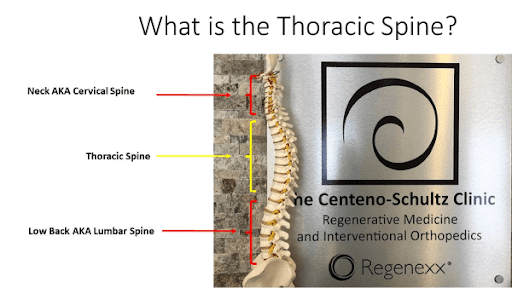
What Is Thoracic Spinal Nerve Pain?
To better understand nerve pain in the thoracic spine, a brief review of the anatomy will be helpful. The thoracic spine is composed of the following structures:
- Vertebral bodies: The boney building blocks that stack one upon another. They are numbered in ascending order, from T1-T12. The T denotes the thoracic spine.
- Intervertebral discs: Sandwiched between each of the vertebral bodies is a disc, which is an important shock absorber. It absorbs the forces of daily living. It is identified by the two adjacent vertebral bodies, for example the T1/2 disc is sandwiched between the T1 and T2 intervertebral bodies.
Thoracic discs are susceptible to injury and degeneration. Examples include thoracic disc protrusions, disc herniations, and disc extrusions.

- Facet joints: A facet joint is a small, paired joint that occurs on the back of the spine. There is a right and left facet joint at every level of the thoracic spine. Each joint is composed of two bones that come together to form a joint: the superior articular process and the inferior articular process.
The joint is lined with cartilage and surrounded by a thick capsule. Together, they function to restrict movement and provide spinal stability.1 - Spinal canal: This is a boney column situated on the backside of the spine. It contains the spinal cord and protective spinal fluid. The fluid bathes and protects the fragile spinal cord. Narrowing of the spinal canal is referred to as stenosis, which can affect the exiting and descending nerves in addition to the spinal cord.
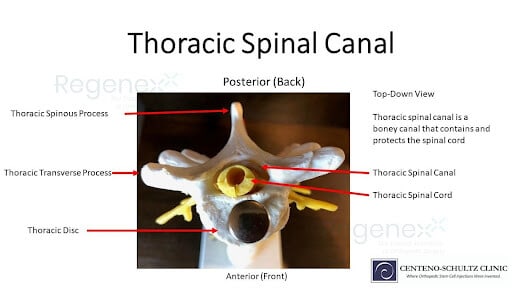
- Neuroforamen: Foramen means opening or doorway in Latin, and neuro refers to nerves. The neuroforamen is the boney doorway through which the nerves exit the spine and travel to various parts of the body. If there is narrowing of the boney doorway, the existing nerves can become irritated, compressed or injured, resulting in nerve pain.

- Ligaments: Ligaments are connective tissues that connect bone to bone. Think of them as human duct tape that provides important stability. If ligaments become thickened, they can cause irritation or compression of exiting nerves, resulting in pain.
If ligaments are too loose, the alignment of the vertebral bodies and discs can be compromised, putting the exiting nerves at risk for irritation or compression.
Accompanying Symptoms of Thoracic Spinal Nerve Pain
Symptoms of nerve pain in the thoracic spine can vary significantly based upon the underlying cause and its severity. Common symptoms include:
- Back pain
- Radiating pain to the front of chest and shoulders
- Numbness and tingling sensation that extends into the chest
- Muscle weakness and stiffness
- Difficulty bending backward
Potential Conditions Causing Nerve Pain in the Thoracic Region
Nerve pain in the thoracic spine also known as thoracic radiculopathy can be debilitating depending upon the severity and injury to the thoracic nerves. The 11 most common causes of nerve pain in the thoracic spine are:
- Thoracic facet arthritis: The facet joint is a paired joint that occurs at every level of the spine. It is formed by the union of the superior articular process and the inferior articular process. It restricts spinal range of motion and provides stability.4
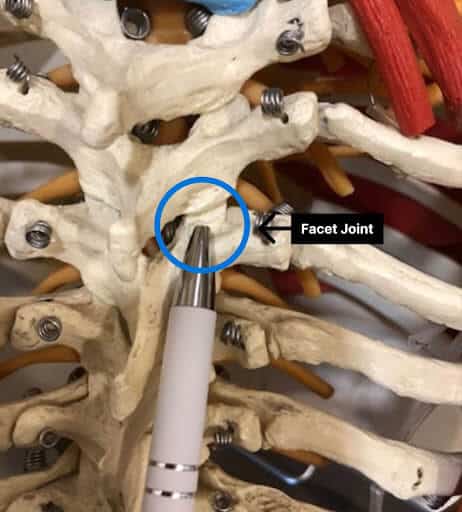
Trauma and degeneration can cause injury to the thoracic facet joints, which in turn can lead to arthritic changes. These arthritic changes can irritate, compress or injure the thoracic nerves.
- Vertebral body misalignment: Vertebral bodies are intended to stack one upon another. During injuries or the degenerative process, one vertebral body may shift forward or backwards in relation to the adjacent vertebral bodies.
When a vertebral body moves forward of the adjacent vertebral body this is called anterolisthesis. Conversely, when a vertebral body moves backwards in relation to the adjacent level, it is referred to as retrolisthesis. “Listhesis” means to slip, “Anterio” denotes movement forward, whereas “retro” refers to movement backwards.
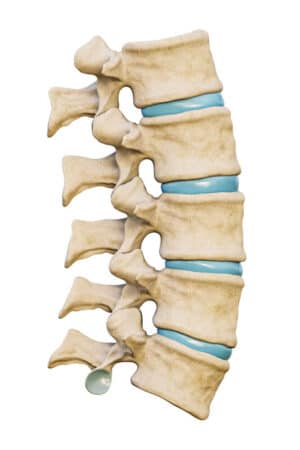
- Bone spurs: A bone spurs is an abnormal bony growth that can irritate, compress or injure thoracic nerves, leading to pain and dysfunction.
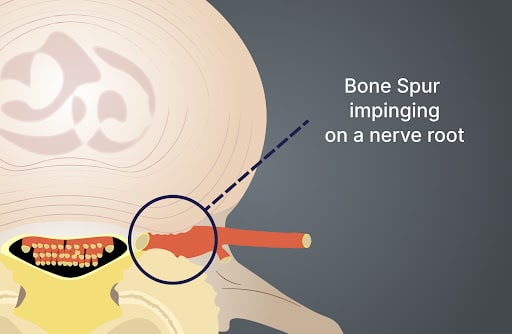
- Muscle strain: There are a large number of muscles in the thoracic spine that can become injured, strained or contracted, leading to irritation or compression of thoracic nerves with subsequent pain.
- Spinal fracture: Inflammatory conditions like ankylosing spondylitis or costochondritis can cause nerve pain in the thoracic spine.
- Infections: Herpes zoster, commonly known as shingles, is a painful medical condition caused by viral infection (varicella-zoster). It affects the nerves and produces a rash and blistering along the path of the nerve.
- Spinal stenosis: Narrowing of the spinal canal can irritate or injure exiting nerves from the thoracic spine, causing pain and dysfunction.
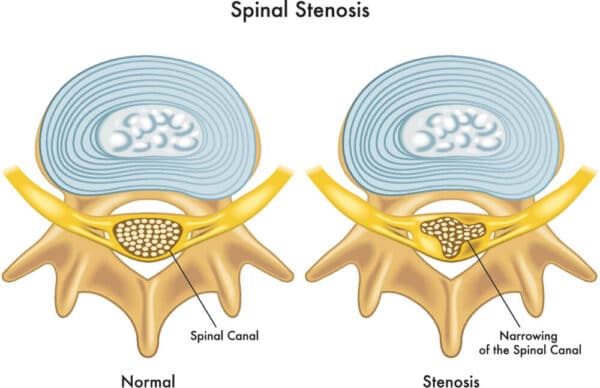
- Tumors: Benign or malignant tumors that are close to the existing nerves can cause irritation or injury resulting in thoracic radiculopathy.
Bone Spurs
Bone spurs, also known as osteophytes, are bony projections that develop along the edges of bones. They are most commonly found in joints — where bones meet — but can also appear on bones where tendons, ligaments, and muscles attach. Bone spurs are often associated with aging and are a common condition. While they can occur in any bone, they’re most often found in areas such as the spine, shoulders, hands, hips, knees, and feet. Bone spurs form as the result of the body trying to repair itself by building extra bone. This process can be triggered by several factors: Osteoarthritis: The most common…
Read More About Bone SpursBulging Disc In Thoracic Spine
A bulging disc in the thoracic spine is a serious medical condition that occurs when the outer layer of the disc weakens, causing it to bulge outward and put pressure on nerves and the spinal cord. The disc has two components, a soft center and a thick outer layer, and weakening or tears in the outer layer can lead to a bulge. Symptoms include pain, numbness, and weakness in the affected area. The thoracic spine is that portion of the spine that resides below the neck and above the low back. It is commonly referred to as the mid-back. A bulging…
Read More About Bulging Disc In Thoracic SpineCostochondritis of the Thoracic Spine
Costochondritis is a medical condition that causes inflammation of the cartilage that connects a rib to the sternum (or breastbone). The term “costo” refers to the ribs, “chondro” refers to cartilage, and “itis” refers to inflammation. Costochondritis typically presents as chest pain and discomfort. It can be sharp in character and may mimic the pain associated with angina or heart attack. The ribs connect to the sternum through a combination of cartilage and joints that form the thoracic cage. The thoracic cage protects vital organs such as the heart and lungs. The end of the rib connects with the costal cartilage, which in turn connects with the sternum.
Read More About Costochondritis of the Thoracic SpineDegenerative Scoliosis
Degenerative Scoliosis, also known as Adult-onset Scoliosis, is a medical condition that involves a side bending in the spine. The bending can be mild, moderate, or severe with side-bending to either the right or the left. The term degenerative means generalized wear and tear and is common as we get older. Degenerative scoliosis is the curvature of the spine that occurs as a result of degeneration of the discs, small joints, and building blocks. The Degenerative Scoliosis curve is often located in the low back and forms a ‘C” shape. There is a convex and a concave side. The convex side is the open side where it curves outward.
Read More About Degenerative ScoliosisHerniated Thoracic Disc
A herniated thoracic disc is especially difficult because there are not as many treatments available as there are for disc herniations in other areas of the spine. To understand Thoracic Disc Herniations, though, we first need to cover thoracic spine anatomy and function. With disc herniation, the annulus fibrosus get small tears throughout the annulus. An annulus is a bunch of concentric fibers, so, as the fibers get damaged and cut, the pressure that is built up within the nucleus pushes the now weakened annulus outward, creating a bulge or herniation. The disc begins to weaken via mild degeneration/tearing of the annular fibers…
Read More About Herniated Thoracic DiscPinched Nerves in the Back
We talk a lot about leg pain stemming from a pinched or irritated nerve in the lower back. And, indeed, that’s what our physicians are traditionally taught in medical school—a pinched nerve in the lumbar spine typically presents as a symptom in the leg. However, what if you have some butt pain but no pain or other symptoms in the leg? Does this mean it couldn’t be a pinched nerve? Not so fast. Turns out a pinched low back nerve doesn’t always have to be accompanied by leg symptoms. Let’s start by taking a look at how the back is structured.
Read More About Pinched Nerves in the BackThoracic Degenerative Disc Disease
Degenerative disc disease is a clinical condition that refers to the gradual deterioration of the discs located in the thoracic spine and the associated symptoms. Pain, weakness, muscle spasms, and restriction in range of motion are common. Degenerative disc disease can occur at each level of the spine: cervical, thoracic, and lumbar. Studies have demonstrated that degenerative disc disease in the thoracic spine most commonly occurs in the third to fourth decades (1) and occurs most frequently in the lower thoracic segments from T7-T12. Thoracic degenerative disc…
Read More About Thoracic Degenerative Disc DiseaseThoracic Outlet Syndrome
The thoracic outlet is an area around the collar bone where the nerves that come from your neck meet up with the blood vessels from your heart and together supply the entire upper extremity (shoulder and arm). These blood vessels (subclavian artery and vein) and nerves (brachial plexus) travel from the base of your neck to your armpit (axilla) and are considered the “thoracic outlet”. Now that you know what the thoracic outlet is, what is thoracic outlet syndrome? Simply listening to a patient’s history and completing a physical examination is all that is needed to diagnose TOS. But more involved imaging such as X-rays…
Read More About Thoracic Outlet SyndromeThoracic Spine Arthritis
Osteoarthritis is a common type of arthritis. It is a degenerative joint disease that principally affects the cartilage in your joints. Cartilage is the slippery connective tissue that covers the ends of bones that form joints, and it allows for smooth, effortless movement. Osteoarthritis involves the breakdown of the cartilage with subsequent pain, swelling, and reduced range of motion. The thoracic spine is that section of the spine that is below the neck and above the low back. It is often referred to as the “mid-back.” Thoracic spine arthritis involves the breakdown of the cartilage in joints within the thoracic spine.
Read More About Thoracic Spine ArthritisThoracic Spine Osteophytes
An osteophyte, also known as a bone spur, is an abnormal bone growth that occurs at the edge of a bone. Thoracic spine osteophytes are bone spurs that occur in the thoracic spine. The thoracic spine is that part of the spine located below the neck and above the lower back. It is often referred to as the mid back. There are many causes of thoracic spine osteophytes. The major cause is instability. A bone spur in most cases is simply the body’s response to an unstable environment.
Read More About Thoracic Spine OsteophytesThoracic Spondylosis
The thoracic spine, also known as the mid back, is that portion of the spine that is below the cervical spine (neck) and above the lumbar spine (low back). Thoracic spondylosis is a degenerative condition of the thoracic spine. The thoracic spine, also known as the mid back, is composed of many important different structures that work together to provide stability and movement. Thoracic spondylosis is a degenerative condition affecting the middle region of the spine, known as the thoracic spine. The major causes include: aging, genetics, poor posture, repetitive strain, and more. Symptoms can be mild, moderate, or severe…
Read More About Thoracic SpondylosisHow to Diagnose the Cause of the Pain
To achieve the best clinical outcomes for nerve pain in the thoracic spine, an accurate diagnosis is essential. At the Centeno-Schultz Clinic, we are committed to determining the actual cause of the pain so that an effective treatment plan can be established.
For example, the treatment of nerve pain in the thoracic spine arising from herpes zoster is much different than that arising from thoracic disc herniations.
An accurate diagnosis involves a detailed medical history, performing a thorough physical examination and reviewing all imaging. This is the standard of care at the Centeno-Schultz Clinic.
Conventional Treatments for Thoracic Spinal Nerve Conditions
Treatment options for nerve pain in the thoracic spine depend upon the underlying cause of the pain and its severity. When appropriate, conservative therapy should always be first line treatment. Common treatments include:
- Medications: NSAIDs (Non-steroidal anti-inflammatory drugs) and low dose narcotics in most cases can manage the pain but do not address the underlying cause of the nerve pain. In severe cases, oral or intramuscular steroids may be prescribed, as they are powerful anti-inflammatory agents.
Common examples include prednisone, dexamethasone, hydrocortisone and oral dose pack. These medications have significant side effects, which have been previously discussed, and for this reason should be avoided.
- Epidural steroid injections: If patients fail to respond to conservative care they may be referred to a pain clinic for epidural steroid injections. These are spine injections intended to reduce nerve irritation and pain.
- Nerve block injections: A specific type of spine injection aimed at the injured nerve root designed to reduce inflammation and pain. These types of injections are performed under x-ray and or ultrasound guidance.
Is Surgery a Viable Option?
Thoracic surgery is a major surgery associated with a significant number of potential risks and complications. These include but are not limited to bleeding, infection, nerve damage, spinal cord injury, dural leak, and failure. There is no guarantee that the pain will improve after surgery and in fact in some patients the pain actually gets worse. Surgery forever changes the biomechanics of the spine, given that ligaments, tendons, muscles and some bone is removed.
Adjacent segment disease (ASD) is a significant concern in those patients who have fusion surgery. The disc and facet joints above and below the fusion are at increased risk for injury and breakdown as a result of the additional forces placed upon them. To learn more, view the video below.
The specific recommended surgery will depend upon many factors, which include the actual source of the thoracic spine nerve pain, its severity, clinical symptoms, findings on physical examination, current medications and past medical history. Common surgeries in the thoracic spine include:
- Discectomy: A discectomy is a surgical procedure to alleviate pain and restore functionality by removing the damaged portion of a disc. It can be performed on any level of the spine, including the cervical, thoracic, and lumbar regions.
The primary objective of a posterior thoracic discectomy is to target the injured part of the disc that is causing discomfort. Moreover, a thoracic discectomy aims to resolve irritation and damage to the spinal cord or nerves caused by the affected disc.
The removal of the damaged disc is anticipated to alleviate pain and alleviate pressure on neural elements, such as the spinal cord, leading to improved well-being.
- Laminectomy: Thoracic laminectomy is a surgical treatment that involves removing a section of the spinal bone to alleviate pressure on the spinal cord and nerves. Similarly, thoracic discectomy aims to remove the damaged and painful portion of the disc.
It is important to note that both procedures carry potential and significant complications, which can be permanent in nature. The recovery process for these surgeries is extensive and may require months of dedicated therapy, often accompanied by discomfort.
It is crucial to acknowledge that surgical interventions do not guarantee improvement in pain or dysfunction, and there is a risk of experiencing life-altering complications. - Fusion: The objective of thoracic spine surgery, known as fusion, is to remove damaged tissues in the thoracic spine that are causing symptoms, thereby aiming to restore the patient to their original clinical state.
The Centeno-Schultz Clinic Approach
The treatment of symptoms with medications, conservative care and pain injections will never provide the best clinical outcome as it does not address and treat the underlying problems.
At the Centeno-Schultz Clinic, we thoroughly evaluate each patient so as to identify the actual source of the pain and dysfunction. This allows us to design the very best treatment plan. It starts with thorough review of medical and surgical history, current medications, onset of pain, alleviating and aggravating factors. This is followed by an extensive physical examination and review of radiographic imaging.
PRP Injections
PRP is short for platelet-rich plasma, and it is autologous blood with concentrations of platelets above baseline values. The potential benefit of platelet-rich plasma has received considerable interest due to the appeal of a simple, safe, and minimally invasive method of applying growth factors. PRP treatments are a form of regenerative medicine that utilizes the blood healing factors to help the body repair itself by means of injecting PRP into the damaged tissue. In regenerative orthopedics, it is typically used for the treatment of muscle strains, tears, ligament and tendon tears, minor arthritis, and joint instability. There have been more than 30 randomized controlled trials of PRP…
Read More About PRP InjectionsPerc-FSU – Trusted Alternative to Spinal Fusion
The Perc-FSU Procedure is an injection-based treatment that utilizes the patients’ own blood platelets to bring stability to the spine without the need for the rods, nuts, bolts, and hardware of fusion surgery. “Perc” stands for percutaneous, and “FSU” stands for “Functional Spinal Unit,” which means that the spine is treated as one functioning unit. Up and down the spine, the discs, facet joints, ligaments, and muscles that assist in stabilizing the spine are treated with image-guided injections of PRP and Platelet Lysate to help bring stability to the spine as a whole. It is the trusted alternative to spinal fusion.
Read More About Perc-FSU – Trusted Alternative to Spinal FusionNerve Hydrodissection
Nerve Hydrodissection is a medical procedure that aims to free up scar tissue or adhesions on a given peripheral nerve. The procedure utilizes ultrasound guidance to visualize both the needle and the targeted nerve. Medication is then injected through the needle to free up the scar tissue. Nerve Hydrodissection is a minimally invasive treatment option for many peripheral nerves that are compressed or entrapped by scar tissue.Pain is an uncomfortable and at times painful sensation. It varies significantly from patient to patient. There are many different types of pain which include inflammatory, nociceptive, and neuropathic. Neuropathic pain is pain that arises from nerve compression or injury.
Read More About Nerve HydrodissectionWhat Are the Complications if It’s Left Untreated?
Nerve pain in the thoracic spine, also known as thoracic radiculopathy, can be debilitating with significant pain and restriction in range of motion. There are 11 major causes of nerve pain in the thoracic spine which include:
- Degenerative disc disease
- Thoracic disc herniation
- Thoracic facet arthritis
- Vertebral body misalignment
- Scoliosis
- Bone spurs
- Muscle strain
- Spinal fracture
- Spinal stenosis
- Tumors
If thoracic pain does not respond to rest, medication or conservative care, this is a signal that you have an underlying issue that warrants additional evaluation. Addressing a minor or small thoracic spine problem is much easier and often has more treatment options with better success than advanced thoracic spine injuries.
If left untreated, degenerative disc, disc herniation, misalignment, scoliosis, stenosis and tumors can progress, resulting in additional pain and limitation. Worst-case scenario would be compression and injury of the spinal cord with the risk of paralysis.
If pain and limitation persist despite conservative care, a thorough medical evaluation and radiographic imaging are warranted. At the Centeno-Schultz Clinic, new patient evaluations are not the standard five-minute physician assist meeting followed by a very brief discussion with the treating physician.
At the Centeno-Schultz Clinic there are no mid-level practitioners. Rather, a board certified, fellowship trained physician will spend extensive time reviewing your past medical and surgical history, onset of pain, aggravating and alleviating factors, and radiographic imaging. A comprehensive physical examination will be performed.
Find the Best Treatment for Spinal Nerve Pain
Nerve pain in the thoracic spine, also known as thoracic radiculopathy, is a major cause of pain, restriction in range of motion and dysfunction in the thoracic spine. There are 11 major causes of thoracic radiculopathy, which were reviewed in detail above.
It is critical that the exact cause of the thoracic radiculopathy is identified so that the best treatment plan can be developed. The best clinical outcomes occur when treating the underlying dysfunction, rather than the symptoms.
If unresponsive to conservative care and rest, an evaluation is warranted, as the condition may be getting worse.
Are you a Candidate?
References
- Jaumard NV, Welch WC, Winkelstein BA. Spinal facet joint biomechanics and mechanotransduction in normal, injury and degenerative conditions. J Biomech Eng. 2011 Jul;133(7):071010. doi: 10.1115/1.4004493. PMID: 21823749; PMCID: PMC3705911.
- McInerney J, Ball PA. The pathophysiology of thoracic disc disease. Neurosurg Focus. 2000 Oct 15;9(4):e1. doi: 10.3171/foc.2000.9.4.2. PMID: 16833239.
- Sarsılmaz A,.
- Jaumard NV, Welch WC, Winkelstein BA. Spinal facet joint biomechanics and mechanotransduction in normal, injury and degenerative conditions. J Biomech Eng. 2011 Jul;133(7):071010. doi: 10.1115/1.4004493. PMID: 21823749; PMCID: PMC3705911.
